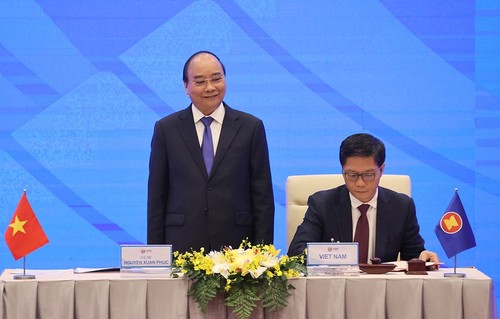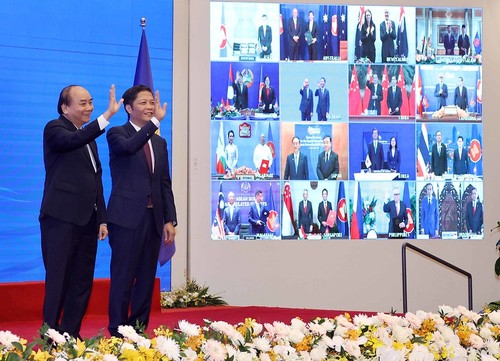 Minister of Industry and Trade Tran Tuan Anh (R) signs RCEP in Hanoi on November 15, 2020, at the witness of Prime Minister Nguyen Xuan Phuc. (photo: baodautu.vn ) Minister of Industry and Trade Tran Tuan Anh (R) signs RCEP in Hanoi on November 15, 2020, at the witness of Prime Minister Nguyen Xuan Phuc. (photo: baodautu.vn ) |
RCEP is an advanced, comprehensive, and high-quality trade agreement between 15 members who have committed to open their markets of goods, services, and investment and simplify custom procedures and rules of origin to facilitate trade activities.
The agreement covers intellectual property, e-commerce, competition, small and medium-sized enterprises, economic and technical cooperation, government procurement, among others.
The world’s biggest free trade agreement, new momentum
RCEP negotiations began in late 2012 among the 10 ASEAN countries and 6 dialogue partners – China, Japan, the Republic of Korea, India, Australia, and New Zealand. In November, 2019, India withdrew from the negotiation due to some unresolved issues.
Once it comes into force, RCEP will form a market of 2.2 billion consumers with a total GDP of 49 trillion USD, nearly a third of the global GDP.
“The agreement symbolizes regional trade liberalization. ASEAN and its partners acknowledge that trade and investment liberalization is a difficult but unavoidable path. This is the world’s biggest free trade agreement at this time and ASEAN has a central role in building the structure. RCEP is a reflection of trade liberalization and cooperation within ASEAN,” said economist Vo Tri Thanh.
 15 countries sign RCEP at an online conference on November 15, 2020. 15 countries sign RCEP at an online conference on November 15, 2020. |
RCEP is seen as a new driving force for global trade for many reasons.
First, it is the only FTA between economies with different development levels and incomes.
Second, ASEAN is the center of RCEP. RCEP’s non-ASEAN members have signed separate FTAs with ASEAN, called ASEAN+1. In the future RCEP is expected to replace all ASEAN+1 agreements.
ASEAN is China’s second biggest trade partner. With RCEP coming into force, ASEAN-China trade and investment will increase rapidly and positively impact the regional value chain.
Third, RCEP takes a broader approach than the ASEAN+1 FTAs. It will remove or reduce 90% of tariff lines. RCEP has clearer definitions of trade, service and cross-border investment, and clearer rules on e-commerce.
Most of the RCEP members have a high economic growth rate and a young population.
RCEP – Vietnam’s hallmark in ASEAN Chairmanship Year 2020
2020 was a difficult year in which to negotiate RCEP because protectionism has emerged in many countries and the geopolitical situation has changed and powers have not reshaped their political relations.
But as the ASEAN Chair for 2020, Vietnam was successful in guiding ASEAN toward the signing of RCEP.
“After many years of negotiation, the signing of RCEP is a big success for ASEAN and its partners, laying a foundation for new, comprehensive, and long-lasting cooperation benefiting regional countries’ development and interests,” said Vietnamese Prime Minister Nguyen Xuan Phuc.
RCEP will take effect once 6 ASEAN countries and 3 non-ASEAN countries ratify it.